#catharus fuscescens
Explore tagged Tumblr posts
Text

I was lucky enough to see a veery in the woods while walking with @alackofcharacter yesterday. They're one of my favorite woodland thrushes with a magical voice that seems to spiral downward. This one stood still long enough to let me get a clear shot. That hardly ever happens! The little wood near my house hosts at least one breeding pair every summer.
#pennsylvania#bird migration#veery#birb#birds#thrush#catharus fuscescens#may#springtime#spring migration#tawny thrush#woodland thrush
230 notes
·
View notes
Text

Veery (Catharus fuscescens)
May 8, 2023
John Heinz National Wildlife Refuge, Tinicum, Pennsylvania
#birds#bird#photographers on tumblr#birdblr#birb#birbs#ornithology#birblr#nature#animals#Veery#Catharus fuscescens
262 notes
·
View notes
Text

Veery
5 notes
·
View notes
Text

Turdus migratorius | Catharus guttatus | Locustella naevia | Catharus fuscescens | Turdus viscivorus | Catharus ustulatus
Plate I | Die Nordamerikanische Vogelwelt (1891)
#bird art#bird illustration#vintage art#vintage illustration#artists on tumblr#thrushes#american robin#hermit thrush#common grasshopper warbler#veery#mistle thrush#olive backed thrush#gustav mützel
263 notes
·
View notes
Text
Uncharismatic Fact of the Day
This little bird is very-- so very, in fact, that it's called the Veery! It's common name actually refers to its call, which was described as a 'veering' metallic trill. Despite its very small size, the veery is also a very strong flier-- scientists have tracked individuals flying 285 km (160 mi) in one night, and at altitudes of over 2 km (1.2 mi)!

(Image: A veery (Catharus fuscescens) by Drew Weber)
#veery#Passeriformes#Turdidae#nightengale-thrushes#thrushes#perching birds#birds#uncharismatic facts
68 notes
·
View notes
Text
The State Birds Initiative: Massachusetts (#6)

Whoa, it's December already? Wow! Been a while since I made one of these, but I honestly needed the break I think. So, uh...where were we? Ah, right.
Welcome to the sixth official poll of the State Birds Initiative! Before the poll, though, one thing real quick, and I cannot emphasize this enough! Read the post below before voting in the poll! It's not a requirement, but it is a real firm suggestion, especially important if you're lacking context about the birds being presented as the new (or old) State Bird of the Bay State, Massachusetts. This is to be fully informed as to why these are being presented, and to make your choices appropriately. Lastly, some of these birds, you will notice, *may *go against some of the rules listed in the introduction post. All is explained after the jump where the explanations are, I promise you that. With that...OK! Here's the poll!
Welcome to the sixth official poll of the State Birds Initiative! Before the poll, though, one thing real quick, and I cannot emphasize this enough! Read the post below before voting in the poll! It's not a requirement, but it is a real firm suggestion, especially important if you're lacking context about the birds being presented as the new (or old) State Bird of the Bay State, Massachusetts. This is to be fully informed as to why these are being presented, and to make your choices appropriately. Lastly, some of these birds, you will notice, may go against some of the rules listed in the introduction post. All is explained after the jump where the explanations are, I promise you that. With that...OK! Here's the poll!

Massachusetts, baby! I've had to travel away from the Bay State in the past week for a conference, but I'm excited to get back to this surprisingly great state. I say surprisingly because Massachusetts' reputation isn't a greatest for those outside of it, but living in it has definitely changed my mind for a number of reasons! That said, the time has come to talk about it a bit. The sixth smallest state in the union, Massachusetts is home to a number of prominent cities, both historically and contemporaneously. There is of course, Boston, the capital and largest city seen above via the big-ass CITGO sign. And while that's the city people equate with the entire state, let's not forget Worcester, Springfield, Cambridge, Lowell, Plymouth, Salem, Amherst, Natick, Cape Cod, etc., etc., etc. There's a whole-ass pile of classic New England cities in this small state, as well as a bevy of habitats and natural spaces.
So, to get into it a bit, Massachusetts is smack-dab in the New England temperate forests, with the highlands dominating the western portion of the state, and a flat lowland coastal region in the eastern half. Forests are temperate mixed, which contributes to the legendary falls that we see in New England. The coastal regions, meanwhile, are glacial in origin, covered in wetlands towards the center of the state, and beaches on the shores. Also of note are the various coastal marshes throughout the state, which serve as their own predominant habitats. Using the BioMap2 project as a framework, let's talk a little bit about these habitats.
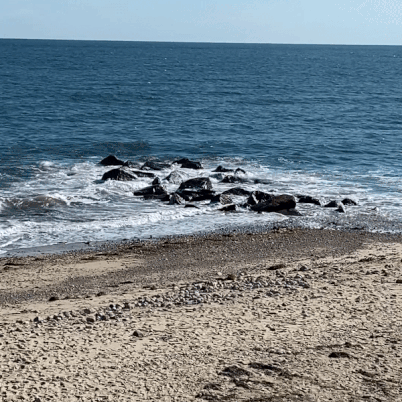
Massachusetts, of course, sits on the Atlantic Ocean, which certainly isn't a first for this list, but is vitally important as we go further north into New England. In the case of Massachusetts, we're looking at sandy beaches and dune habitats as prominent foraging and nesting areas for various shorebirds, which does make shorebirds a high likely focus for this list. Some of you probably know one of the most important birds we'll be looking at, but we'll get to that one, don't worry.
Alongside the beaches, estuaries are a prominent habitat along the shorelines. Places like Plum Island, in northern Massachusetts, or Belle Isle Marsh in the middle of Boston itself, personally come to mind. Massive saltmarshes that are vital stopover habitats for migrants, habitats for insects and endangered turtles, and coastal salt ponds and tidal marshes that house incredible biodiversity within them. There's a lot of focus coming to the coastlines, that's what I'm saying. All of these habitats and the species within them comprise about 41,000 acres of land, and about 75% of that is in danger from development and rising sea levels.
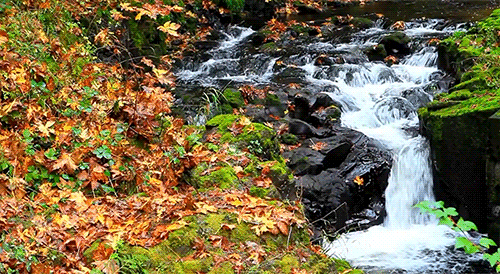
Now, I'm gonna skip over a bunch of other habitats here, especially freshwater wetlands and riparian habitats, because while these are extremely important, they won't be getting as much focus here. Now, we need to move on to the forests. I've talked about them before in Connecticut, New Jersey, and Pennsylvania, but we've got a very specific situation here in Mass. Here, because of the large number of people and settlements, fragmentation is a very prominent problem in the state. For the uninitiated, habitat fragmentation is basically what it sounds like: splitting up habitat by roads or other man-made corridors, breaking up populations of several animals, birds included. Doesn't sound like a big deal to animals that can fly, but birds don't like crossing corridors if they can help it, because it makes them vulnerable to predation (of adults and nests) and car strikes. So, forests of New England and Massachusetts are a habitat of needed focus. And while this will receive a slightly lesser focus, most likely, it's still a place we'll take a look at.
These three habitat types, wetland, coastal, and forest, are the most important in Massachusetts, as well as in New England (which, again, will change slightly as we head further north). But there's also the ever-important human element to consider, ESPECIALLY here.

While I said Boston doesn't define the entire state, and it doesn't, it's also the second most populated city on our list of states thus far, and happens to be one of the most important places in the country historically. Let's not forget, this is basically the seat of the American Revolution in many ways, so it's a pretty major part of our cultural identity as a country. And trust me, Boston is fully aware of that fact. I'm never one to dabble in stereotypes, but Bostonians are extremely proud to be Bostonians most of the time. It's a proud city, and that's understandable from a traditional point of view.
Plus, with Plymouth Rock 40 minutes to the south (and not worth the drive, from what I've heard), the textile-based seat of the American Industrial Revolution 40 minutes to the north (looking at you, Lowell), the site of the "shot heard round the world" 15 minutes away (Concord and Lexington, of course), the oldest American university 5 minutes away (Cambridge, of course), and the home of the legend of the American witch about an hour north (Salem, of course)...look, it's a central hub of the state, and it WILL not be ignored! So, with that said, grab some coffee from Dunks and some clam chowdah, let's settle in and check out some birds!
If anybody has a suggestion that I hadn't brought up here, send it my way! I will absolutely add another poll if there are entries I think could bear fruit. But, in the meantime, read on if you're interested in the possible choices for the State Bird of Massachusetts!
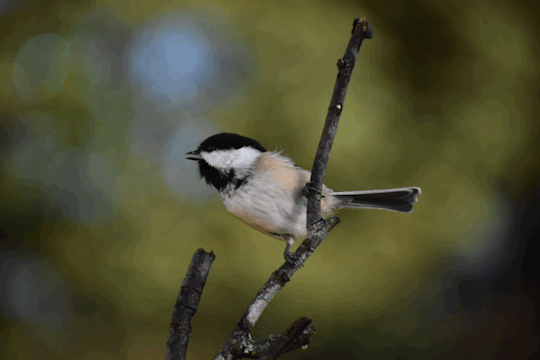
Black-capped Chickadee (Poecile atricapillus)
I gotta say, I have a real soft-spot for these guys. Although, to be fair, I think most people do! Named after their iconic call, and their memorable black cap, the Black-capped Chickadee (Poecile atricapillus) is one of the most iconic birds of New England, and arguably of North America. I say arguably only because there are a few chickadees in the United States, but the Black-capped is one of the most famous. We'll revisit the rest in two later posts, but this one is our focus today.
This bird was originally chosen because, well, it's iconic. I assume. To be honest, I don't actually know why it was chosen, outside of it being recognizable. It's also possible (POSSIBLE) that it was inspired by nearby Maine's choice of State Bird. But that's a choice we'll get to at a later date, I promise you that. As for the BCCH here, does it fit the state? I'll be honest, I actually like the chickadee for Massachusetts' State Bird. Partially, that's because it's a bird that can be found all throughout it with no difficulty, and it's an excellent beginner bird for kids (and just-starting amateurs). But, it's also small and incredibly scrappy, just like Massachusetts. I've had these guys in hand before, and I tell you, these little bastards'll hammer away at your cuticles with their beaks to get you to let them go. Doesn't hurt, unless they really try to grab on and twist at a sensitive spot, but they're fighters!

They're also quite social and vocal, which also fits residents of the Bay State. They have a unique language, with an alarm call that's recognizable by multiple bird species for warning, and it's also their most famous call ("chick-a-dee-dee-dee-dee"). The more "dees" there are, the higher the perceived threat is, fun fact. They hang out in groups in the winter, both with other chickadees and other birds, and their brains generate new neurons in the autumn and winter to remember and navigate to places where they can find food during a difficult harvesting season. That's how I feel when I have to remember where the nearest Dunks is for coffee, not gonna lie.
I realize that I'm making some convincing arguments for the incumbent here, but...yeah, there's a reason. I do honestly think this is a solid choice for the State Bird of Massachusetts, so I'll support its re-election if that occurs. But with that said and presented, let's move on to the challengers. Some are good, some are mediocre, and some are a bit surprising. And some...should maybe belong to a different state.
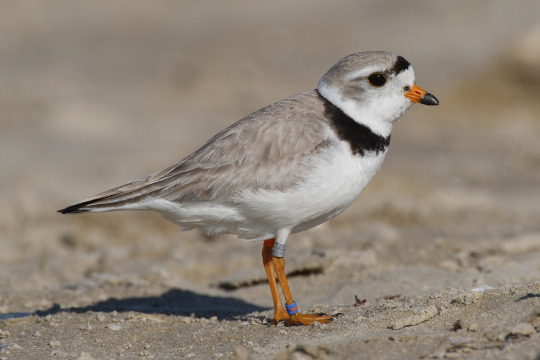
Piping Plover (Charadrius melodus)
eBird's suggestion is, unsurprisingly, the Piping Plover (Charadrius melodus), because a whopping 25% of the breeding population can be found in Massachusetts, according to eBird Status and Trends. And WOW, that is a massive proportion. That means, just to make this clear, one in 4 of ALL Piping Plovers are born in Massachusetts. Significant proportion, meaning that this has a claim on the role of MA State Bird for that reason alone. And Massachusetts certainly knows this, as several beaches in the state are shut down during the plover breeding season to allow them to nest in peace, without human disturbance.
In fact, when Piping Plovers were declared endangered in the Endangered Species Act, Mass Audubon launched the Coastal Waterbird Program to protect them and a later entry on this list. The population has exploded tenfold in the last 40 years of conservation work, and these are a pretty easy to find species now, if you're looking for them. This is a great introductory bird, both to conservation efforts, and to shorebirds (which are notoriously difficult to identify). It's also, surprisingly for shorebirds of this ilk, pretty easy to identify. And also...they're incredibly cute. I mean, have you seen the babies? It's crazy how cute they are. Seriously, LOOK AGAIN. Precious. Another solid candidate, and an excellent representative of the beaches of Massachusetts.
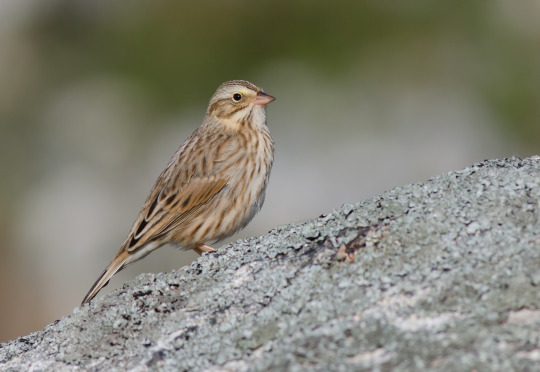
Ipswich Sparrow (Passerculus sandwichensis princeps)
Ah, the Savannah Sparrow (Passerculus sandwichensis). We meet again. Sorry to abandon you back there in Georgia, but to be fair, you were only nominated there because you're named after a major city in the state. But here...ah, wait, right, same thing. Now, to be fair, you've probably mentioned that the nominated bird is the Ipswich Sparrow (Passerculus sandwichensis princeps), not the Savannah Sparrow. But this is, of course, a subspecies of the Savannah Sparrow, named after Ipswich, Massachusetts due to its first sighting there. Larger and paler than its compatriots, the Ipswich Sparrow is known from Massachusetts...but breeds in Nova Scotia. Yeah, we've got another Connecticut Warbler (Oporornis agilis) situation here. Yikes.
So, is there a reason to nominate this bird for Massachusetts outside of its name? Well...actually kinda. These pale sparrows are, to be fair, pretty uniquely found in Massachusetts. And, while this isn't the only place you can see it, it is a reliable place to find it. It's sighted on the dunes on the Massachusetts coast, blending in with the light-colored sand, and making its way to and from Nova Scotia, where it only breeds on one island. So, conservation concern (and focus), seen in the state (even if it doesn't breed there), relies on some of its habitats of focus (saltmarshes and coastlines), has a tie to it that's unique to Massachusetts...it's something. Not as good as other options, but...something. In any case, let's move on.
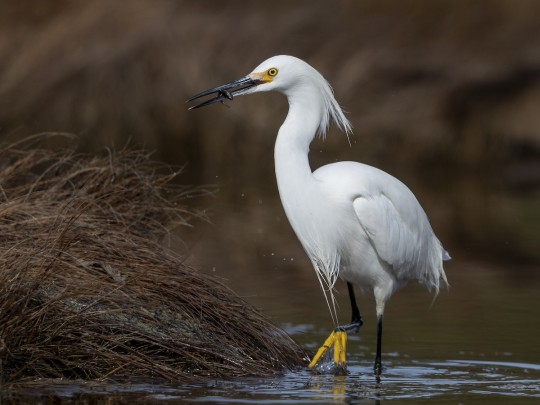
Snowy Egret (Egretta thula)
Hold on. We saw this guy in the Connecticut post! What is this post, a bunch of repeats? Well, to be fair here, the Snowy Egret (Egretta thula) is a slightly better fit for Massachusetts than it was for Connecticut...for the exact same reason it was suggested for Connecticut. Well, part of it, anyway. I stand by the idea of applying the "macaroni" label to the Snowy Egret to fit with Connecticut, but it's the Audubon Society part I'm focusing on here. Lemme quote the previous post:
To be clear here, quite a lot of birds were used in millinery back in the day, but the Snowy Egret (and the Great Egret (Ardea alba), for that matter) are special. Those long white feathery plumes were heavily prized as hat decorations, enough so that the species nearly went extinct from hunting them for the hat trade. As a result of that, people began to turn their eye towards conservation of the species, and the protection of birds in general. Two women, Harriet Hemenway and Minna B. Hall, got a group of women together to protect the birds. They rallied the troops, and their organization became fairly popular. Eventually when they sought to name it, they did so after one of the most famous ornithologists in American history at the time: John James Audubon. And from there...well, you can guess.
The Audubon Society is one of the premiere bird conservation organizations in the world, and especially in the United States, and is well-known to the public sector. And it was born right here in...Massachusetts. Oh. Wait, have I jumped the gun on this one?
I had, indeed, jumped the gun. So, to fix that now, let's throw the Snowy Egret in here instead! After all, it does breed in the state (a little bit), and I actually saw some earlier this year in Parker River NWR! It has a historical tie, and to the largest conservation organization in New England! Trust me, Mass Audubon is a MASSIVE deal up here, and their link alone gives me cause to put the Snowy Egret on this list. That said, though...that's not their logo.
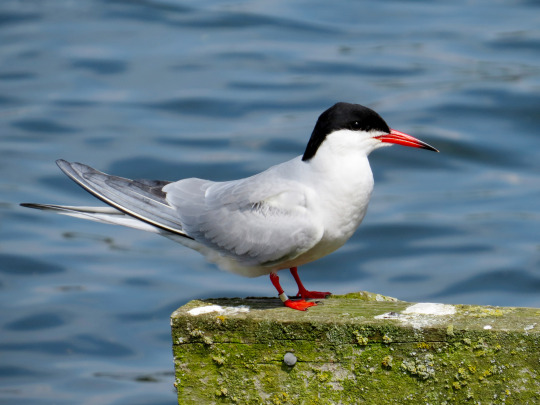
Common Tern (Sterna hirundo)
To my genuine surprise, the logo for Mass Audubon is actually the Common Tern (Sterna hirundo), an aerial and acrobatic seabird found on the shores of Massachusetts, in some surprising places. In Massachusetts, though, there's a major tie to conservation and the Common Tern, because this is actually one of the birds whose feathers were stolen for hats, inspiring the foundation of the movement. Yeah, both the Snowy Egret and this species, which was (and is) more common here. So, if there's an Audubon-related bird to be elected, it probably should be this one, to be honest. This is a species, understand, that was crashing in population in the late 1800s, and was saved from hunting by a young Mass Audubon. Between 1889 and 1920, the population bloomed eightfold, from 5,000 pairs to 40,000 pairs. An impressive population boom in every possible way. However, that wouldn't last.
Herring Gulls (Larus argentatus), human activity, and various other disturbances have created numerous population crashes and bottlenecks in the species' history in Massachusetts, keeping them a conservation focus to this day. The species has notably spread throughout the state's coastlines to this day, and they aren't terribly hard to find. In fact, you can see them in the Boston Harbor, from the shore! I've seen Common Tern from the New England Aquarium very often, in fact, and it's sort of magical to see them smack-dab in the middle of the city. Their habitats of beaches and shorelines need to be maintained and protected, so throwing the conservation focus on them is incredibly valuable for the species' future. A solid choice for State Bird (or another category sponsored by the SBI), if ever there was one.

Veery (Catharus fuscescens)
But wait, coming in at the last moment, just making it, the Veery (Catharus fuscescens)! Yeah, this one's a bit of a surprise, but I found out some very interesting info recently. The Black-capped Chickadee (Poecile atricapilla) was not the first nominee for State Bird; instead, in 1931, the State Federation of Women's Clubs (yup, another woman's organization) nominated the Veery for the State Bird...and got shot down. It took them ten years to nominate the Chickadee for unknown reasons, meaning the Veery probably didn't even get its day in court. Shameful! So, let's try and rectify that here, shall we?
Veery are thrushes, famous for the beautiful, ethereal calls that give them their name. This is a robin-sized migratory songbird that breeds in the forests of New England and southern Canada, and are an iconic New England bird in their own right. They're found in forested wetlands (that's two habitats of concern in MA), usually fairly close to beaver ponds, and the two species are often associated. It's also a species mentioned in Henry David Thoreau's Walden, one of the most important environmentalist literary works in American history, as well as an important Massachusetts story. It's also currently spreading in the state, increasing the size of its range, while also experiencing slightly decreasing populations, meaning that focus is still needed. And again...that song. It's a delight to hear it in forests, and recognizing it is a great step for beginning birders to pay more attention to the sound around them.

And with that...yeah! We'll end it there! Only six nominees, and you're probably wondering what's happened to the State Raptor and State Game Bird. Well...I'll explain that once we get to the results. Because that's a bit more complicated then expected.
See you next time, and happy birding!
Introduction to the State Birds Initiative
1. Delaware - Poll | Results 2. Pennsylvania - Poll | Results 3. New Jersey - Poll | Results 4. Georgia - Poll | Results 5. Connecticut - Poll | Results 6. Massachusetts - Poll | Results
#bird#birds#birding#birder#birders#birdwatching#black birder#state bird#state bird initiative#state birds initiative#birdblr#birblr#poll#tumblr poll#birds of tumblr#black-capped chickadee#piping plover#snowy egret#ipswich sparrow#common tern#veery#chickadee#plover#egret#sparrow#tern#thrush#massachusetts#birdposting
62 notes
·
View notes
Text

Veery (Catharus fuscescens), High Island, Galveston County, Texas.
110 notes
·
View notes
Text
[CM] Birds - Biyaw 2
Our final bird post! At least until I inevitably find some Maine birding guide that introduces a new species, haha. Today’s the second half of the biyaw* list, birds that are common and easily hunted.
Below are translations for sparrows, vireos, and a whole lot more.
Northern waterthrush (Parkesia noveboracensis) - Chochocho Streaky brown-and-cream bird. Present in summer and fall. Feed on insects, snails, fish, and salamanders. Known for foraging along watersides in the bog.
Wood thrush (Hylocichla mustelina) - Wupwiurr Brown-and-white thrush with a spotted chest and belly. Present in summer. Feed on insects and berries.
Veery (Catharus fuscescens) - Veerr Brown-and-white thrush, similar to a wood thrush but unspotted. Present in summer. Feed on insects and berries.
Song sparrow (Melospiza melodia) - Hipchee Brownish sparrow with heavy streaking and red stripes on the head. Present year-round. Feed mostly on insects and seeds.
Swamp sparrow (Melospiza georgiana) - Sees Brown sparrow with an unpatterned belly. Present year-round but most abundant in spring, summer, and fall. Feed mostly on insects.
White-eyed vireo (Vireo griseus) - Pikchikawee Gray-and-yellow vireo with white eyes. Present sparingly in summer and fall. Feed on insects and berries. The word pikchikawee is derived from a mnemonic I saw for white-eyed vireo calls!
Yellow-throated vireo (Vireo flavifrons) - Ee’earp Mostly gray bird with a yellow-olive head and white underparts. Present sparingly in summer. Feed on insects, fruit, and seeds.
Warbling vireo (Vireo gilvus) - Wiuwiu Dull gray bird with a slightly lighter belly. Present in summer and early fall. Feed mostly on insects, but eat berries as well.
Blue-headed vireo (Vireo solitarius) - Wee’rip White-and-olive bird with a blue-gray head and white eye rings. Present in summer and fall. Feed on insects and small fruit.
Marsh wren (Cistothorus palustris) - Pich Little chocolate-brown bird with a distinct body shape, often seen perched while bobbing its tail. Present year-round but most abundant in summer. Feed mostly on insects.
Alder flycatcher (Empidonax alnorum) - Rebeer Grayish-brown and white flycatcher with a small head crest. Present in summer. Feed on insects - can be seen flycatching, darting off a branch to catch bugs mid-air!
Phoebe (Sayornis phoebe) - Weebee Small flycatcher with a dark brownish-gray back and white underparts. Present year-round but most abundant in summer and fall. Feed on insects and berries.
Bittern (Botaurus lentiginosus) - Wikbwip Small heron with brown-and-cream streaking and a long striped beak. Present in spring and summer, sometimes seen in fall. Feed on fish, frogs, insects, and other aquatic life. Bitterns have some unique nicknames - my favorite is��“mire-drum”.
8 notes
·
View notes
Text
Veery (Catharus fuscescens)
imagine spending 700$ on ticketmaster meanwhile his concerts are literally free
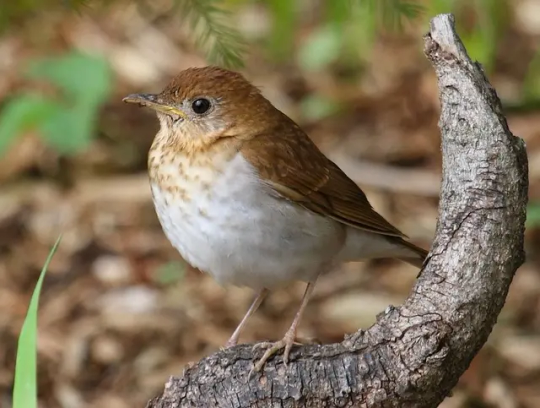
13K notes
·
View notes
Photo

Veery (Catharus fuscescens), at Wehr Nature Center at Whitnall Park, Milwaukee, Wisconsin.
#photographers on tumblr#veery#Catharus fuscescens#Wehr Nature Center#Whitnall Park#Milwaukee County#Milwaukee#Wisconsin
80 notes
·
View notes
Photo

A new variant has been added!
Veery (Catharus fuscescens) © Gustav Mützel
It hatches from beautiful, bright, brown, central, colored, indistinct, rare, reddish, spiral, upper, warm, white, and wooded eggs.
squawkoverflow - the ultimate bird collecting game 🥚 hatch ❤️ collect 🤝 connect
0 notes
Photo


Also saw this which appears to be a veery, another kind of thrush! And I saw my first catbird of the year. I’ll soon be seeing and hearing countless catbirds all the time but first catbird of the year is still a thing. From now until the 20th of May I will probably give up all pretense of being a responsible person and just go out birding whenever I can. At some point at the end of it I’ll post a list of migrating birds I saw. You can see anything anywhere now. I had an ovenbird in my back garden the other day. Keep your eyes (and ears) open if you’re in the eastern US!
198 notes
·
View notes
Photo



A trio of thrushes
Swainson’s thrush (Catharus ustulatus)
Wood thrush (Hylocichla mustelina)
Veery (Catharus fuscescens)
May 2020
Southeastern Pennsylvania
#bird#birds#photographers on tumblr#thrush#thrushes#veery#wood thrush#swainson's thrush#Catharus fuscescens#Catharus ustulatus#Hylocichla mustelina#birdblr#ornithology#birblr#birds on tumblr
134 notes
·
View notes
Photo

Happy Feathursday!
Nest and eggs of a veery (Catharus fuscescens). SciArt by Virginia Smith Jones for Illustrations of the Nests and Eggs of Birds of Ohio, Vol. 2 (1886). View in Biodiversity Heritage Library (@biodivlibrary) with thanks to Smithsonian Libraries (@SILibraries) for digitizing.
#Feathursday#birds#Ornithology#Veery#Verries#SciArt#HerNaturalHistory#WomeninSciArt#WomeninHistSciArt#WomeninBHLib#BHLib#Biodiversity Heritage Library#SmithsonianLibraries#Ohio#Nest#Eggs
16 notes
·
View notes
Text
Art: it’s in our Nature
The prompt “who are you to interpret nature through art” appears to question whether we have the ability or authority to use art for nature interpretation. I believe any nature interpreter has the potential to use art to inspire people. We cannot overlook the opportunity to use the arts to inspire and teach people about nature.
Art and nature share a connection based on beauty, and nature interpreters can help people find beauty. Freeman Tilden, a pioneer of nature interpretation, suggested that interpreters “…prepare the visitors to be receptive to beauty” (Beck and Cable, 2011, p. 135). Though not a nature interpreter, our guide at the Guelph Art Gallery did much the same thing: she presented us with information that we could use to form our own opinions about the art. I agree that as interpreters, we cannot dictate what is beautiful to our audience. We can, however, help people find beauty in nature. And that appreciation can motivate people to protect wildlife and landscapes (Beck and Cable, 2011).

I had to look closely at shape, texture, and patterns when I drew this wood frog (Lithobates sylvaticus). Close observation helped me appreciate these little frogs and their place in nature! Drawing is my own.
I’m sure I’m like many of you in that I find beauty in nature. Nature is the main subject of my art and photography. A key realization for me occurred when I was reminded that “[nature’s beauty] encompasses all of our senses” (Beck and Cable, 2011, p. 137). Previously, I’d only really considered natural beauty that is perceived visually. Things like the vibrant colours of leaves in fall, or the symmetry of the shoreline reflected in calm water, or the intricate patterns of a bird’s plumage. I think because I’m more of a visual learner I’ve always narrowed in on visual beauty in nature.

I tried to capture the beauty of early morning with mist coming off the river in this painting (based on a local landscape). Painting my own.
The textbook describes how we can help people find beauty in ordinary landscapes (Beck and Cable, 2011). Yes, we can show people where to look for beauty, but let’s not forget to teach people how to look for beauty. How can you use your senses to perceive natural beauty?
What is a beautiful sound in nature? For me, birdsong is the most beautiful sound in nature (especially the Veery, the Common Loon, and the White-throated Sparrow).
How about a beautiful smell? I love the smell of fir and cedar.
Maybe there’s even a beautiful feeling you find in nature. I love how dark rocks that have been exposed to sun all day continue to radiate heat after sunset.
vimeo
Turn your volume up for this one! You can hear a few Veeries (Catharus fuscescens) singing. Video my own.
Beck and Cable (2011) suggest encouraging your audience to slow down and inspect details while searching for beauty. I think we can use multiple artistic media to do this. For example, recording audio of some sounds they heard; using sculpture to recreate a texture found in nature; writing a description of the landscape around them; or using paint to match the colours they see in nature. Art can be a powerful tool for noticing and appreciating beauty in nature.
Citations
Beck, L., & Cable, T. T. (2011). The Gifts of Interpretation: Fifteen Guiding Principles for Interpreting Nature and Culture. Urbana, IL: Sagamore Publishing.
5 notes
·
View notes
Text
Early hird late bird kohls

2012, Scott & Durden 2014).Įxtralimital transport of ticks between continents by wild birds can occur, during hemispheric and intercontinental flight ( Hoogstraal & Kaiser 1961, Olsen et al. minor, are transported from the southeastern United States and the Neotropics by passerines ( Scott et al. These songbird-carried Amblyomma ticks include: A. Some other Neotropical and southern Nearctic Amblyomma species have been previously reported during spring migration on songbirds (Passeriformes) in Canada. rotundatum on amphibians and reptiles can cause exsanguination and death ( Keirans & Durden 1998). Of note, severe parasitic infestations of A. In South America, this obligate, hematophagous ectoparasite is also known to feed on certain mammals, including humans ( Guglielmone & Nava 2010). rotundatum is now established in localized areas within the southernmost fringe of the Nearctic Region. 2011) and southern part of Florida ( Oliver et al. This parthenogenetic tick has a biogeographical range from Argentina to Mexico, including the Caribbean Islands ( Jones et al. Amblyomma rotundatum Koch, 1844 is a hard-bodied tick (Acari: Ixodida: Ixodidae) that is typically found on amphibians and reptiles. Ticks are vectors of many human and other animal disease agents ( Nicholson et al. rotundatum into Canada, and be alert that this tick species signifies an unforeseen public health risk to humans. Health-care providers should take note that migratory songbirds can transport A. rotundatum is known to harbor bacteria that are pathogenic to humans. rotundatum thousands of kilometers during northward spring migration. We provide formidable evidence that migratory songbirds can carry A. rotundatum and the first record of this species on a bird anywhere. Notably, this novel collection is the northernmost record of A. rotundatum on a Veery constitutes a first tick-host record, and a new distributional record in Canada. In the laboratory, this nymph molted to a female in 44 d. During our tick-host study, we collected a nymphal Amblyomma rotundatum Koch, from a Veery, Catharus fuscescens (Stephens) (Passeriformes: Turdidae), at Long Point, Ontario, Canada. Migratory birds disperse engorged ticks across Canada during northward spring migration.

0 notes